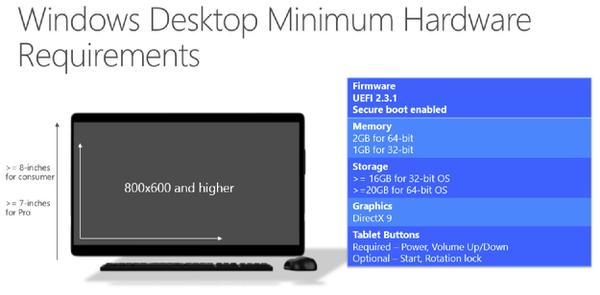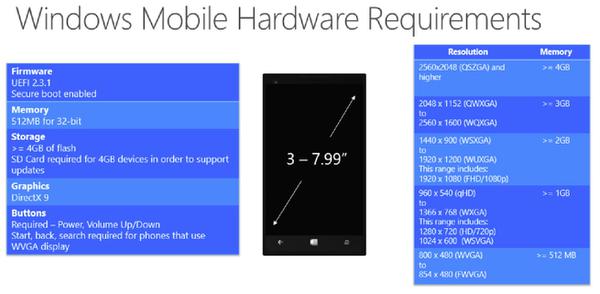Windows 10 desktop and mobile hardware
Microsoft has published minimum hardware requirements for both desktop and mobile devices running Windows 10. In what might be considered by some to be a strange quirk, the specs allow 'desktop' devices with screens of just 7-inches while 'mobile' devices can sport screens as large as 7.99-inches. This information came from the Windows Hardware Engineering (WinHEC) conference in China this week, via PCWorld.
Desktop windows PCs, as mentioned above, can have screens as small as 7-inches and resolutions as low as 800 x 600 pixels. The memory and storage requirements vary depending on whether the device packs 32-bit or 64-bit Windows. These are 1GB RAM/16GB storage and 2GB RAM/20GB storage respectively. Devices must use the UEFI 2.3.1 firmware interface and a Trusted Platform Module (TPM). Minimum graphical requirements are a DirectX 9 compatible GPU. Tablets require at least a power and volume up/down control with rotation lock and Start Button optional.
Mobiles powered by Windows 10 have the same UEFI, graphics and required buttons as the tablets above. Optional buttons include Start, back and search but these buttons must be implemented in the lowest resolution (WVGA, 800 x 480 pixels) phones due to no spare screen space for these controls. Mobile storage must be at least 4GB, supplemented by an SD card in that case. RAM must be at least 512MB for 32-bit.
As mentioned above, screen sizes of Windows 10 mobiles can be as big as 7.99-inches. Screens as small as 3-inches are also OK. Screen resolutions and minimum RAM requirements are related and shown in the table directly above (click to enlarge it). You can see that Microsoft will require 4GB of RAM or more on devices with 2560 x 2048 (QSZGA) or higher res screens.
Other minimum phone must-haves include the obvious; a cellular radio supporting data and voice, a loudspeaker, earpiece and microphone, headphone jack, vibration ability.
Moving Android devices to Windows 10
Yesterday we briefly touched upon the news that users of the Xiaomi Mi 4 smartphone (in China) will be able to download and install Windows 10 for their devices. This smartphone ships with Android. TechCrunch has a few more details about this programme. The site says that the Windows 10 install will not offer dual-boot but completely replace the Android OS. Furthermore Microsoft will make a ROM available for other devices in the future. That's an interesting way of growing the Windows mobile market share.















